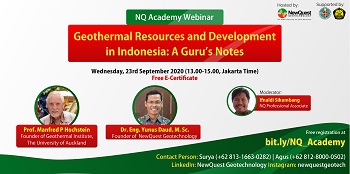NEWS
Review of NQ Academy Webinar #6: From Large-Scale Tectonics to Field-Scale Geothermal Systems
NQ News
Wednesday, March 3, 2021
NQ Academy Webinar #6 has been held on February 27, 2021. The webinar was presented by Dr. (cand) Lukman Sutrisno, a Ph.D. candidate in Tectonics & Geothermal on Joint Supervision Ph.D Program between Utrecht University (Netherland) and Universitas Indonesia. The Webinar was hosted by Dr. Yunus Daud, Founder of NewQuest Geotechnology, and was discussing the topic of "From Large-Scale Tectonics to Field-Scale Geothermal System: Lessons Learned from Sumatra". The 6th NQ Academy Webinar was well organized and attended by more than 150 participants.
The speaker use Sumatra as a case study and was discussing about two different things, those are the large scale tectonics with hundreds of kilometers spatial resolution and geothermal field scale with merely several kilometers size, and how the two phenomena were related?
Sumatra is a result from long live active margin (convergent movement repeatedly) begin from Paleozoic era (about 200-300 million years ago) until nowadays. This long live convergent movement affects the latest subduction, volcanism, and micro-continent plates of Sumatra. The convergent movement of Sumatra is an oblique convergence type which yield Sumatran Fault system (SFS).
In term of tectono-volcanic domains (TVD), the SFS is devided into 3 TVDs. The first TVD is the Northern TVD which is dominated by compressional/ transpressional system. The volcanism in this section are shifted to the Eastern part of the SFS. The second TVD is the Central TVD which has characteristics almost the same as the North TVD, but has more voluminous magmatism/ volcanism than the Northern section since it is associated with slab tearing. The third TVD is the Southern TVD which is dominated by strike slip deformation. In this area, the Volcanism and SFS are coexist.
Compared to geothermal system in Java, the Sumatran system is relatively different with Java system. In Sumatra often found the basement on the drilling process. Moreover, we can also found the basement outcroping on the surface. While the basement on the Java system is very deep. Even we drilled up to 3 km, the basement can not be found.
At the end of the presentation, the speaker concluded that there are associations between large-scale tectonic setting with field-scale geothermal systems. The speaker also showed the implication and resource risks of geothermal systems which are related to transtensional setting, tranpressional setting, and strike-strip fault. Each systems resulted in different characteristics in geothermal play, temperature, permeability, and lateral extent.


Gravity Survey and Magnetotelluric Data Processing of Jailolo Geothermal Prospect Area, West Halmahera
NQ News, Monday, 11 April 2022

Press Release: NewQuest Geotechnology Anniversary Day - A Ten Years of Contributions
NQ News, Monday, 25 of October 2021

SPECIAL NQ 10 YEARS ANNIVERSARY DAY “Geothermal Technology Innovations: A Perspective from...
NQ News, Thursday, 21st of October 2021

Special NQ Training: “Magnetotelluric (MT) for Geothermal Exploration”
NQ News, Monday, 4 October 2021

Special NQ Training For Public Society: “Geothermal Energy: A Special Gift for Indonesia”
NQ News, Thursday, 30 September 2021

Review of Special NQ Academy Webinar #10: Technology & Innovation to Accomplish Geothermal...
NQ News, Thursday, 16 September 2021

NQ Ten Years Anniversary: Contributions for National Prosperity Through Continuous Innovations
NQ News, Tuesday, 1 September 2021

NQ Academy Webinar #10: Technology & Innovation to Accomplish Geothermal as Affordable Energy
NQ News, Tuesday, 1 September 2021

Review of NQ Academy Webinar #9: Steam Field Management: Problems and Troubleshootings
NQ News, Monday, 16 August 2021

NQ Academy Webinar #9: Steam Field Management: Problems and Troubleshooting
NQ News, Friday, 30 Juli, 2021

GEOTHERMAL MEDIUM TEMPERATURE RESOURCES IN MALAYSIA, THAILAND AND INDONESIA
NQ News, Wednesday, May 5, 2021

Review of NQ Academy Webinar #8: Lessons Learned from Geothermal Exploration in Muara Laboh
NQ News, Monday, May 3, 2021

NQ and IMT-GT Webinar on Exploration & Utilisation of Low-Medium Geothermal Resources...
NQ News, Friday, April 23, 2021

NQ Academy Webinar #8: Lessons Learned from Geothermal Exploration in Muara Laboh
NQ News, Wednesday, April 21, 2021

Review of NQ Academy Webinar #7: Geothermal Production Processes through Geochemical Interventions
NQ News, Thursday, April 1, 2021

NQ Academy Webinar #7: Optimization of Geothermal Production Processes through Geochemical Interventions for ...
NQ News, Thursday, March 25, 2021

NQ Academy Webinar #6: From Large-Scale Tectonics to Field-Scale Geothermal System: Lessons Learned from Sumatra
Thursday, February 25, 2021

Review of NQ Academy Webinar #5: Final Preparation of Government Drilling Program
NQ News, Friday, February 5, 2021

WKP Cisolok Cisukarame: First WKP to drill in Government Drilling Program
NQ News, Tuesday, February 2, 2021

Review of NQ Academy Webinar #4: Geochemical Signatures over Volcanic Geothermal Systems
NQ News, Wednesday, December 23, 2020

NQ ACADEMY WEBINAR #4: Geochemical Signatures over Volcanic Geothermal Systems
NQ News, Wednesday, December 16, 2020

The Three Million Dollars Well: A Lesson Learned from Geothermal Drilling in Indonesia
NQ News, Monday December 7, 2020

NewQuest Geotechnology & North Tech Drilling Signed a Strategic Partnership Agreement
Press Release: Monday November 30, 2020

NQ ACADEMY WEBINAR #3: THE THREE MILLION DOLLAR WELL: A LESSON LEARNED FROM ...
NQ News, Thursday November 19, 2020

NQ SURVEY AND EXPLORATION IN MALAYSIA AND PROSPECTS FOR GEOTHERMAL DEVELOPMENT ...
NQ News, Monday November 16, 2020

WKP TANGKUBAN PERAHU, DEVELOPING GEOTHERMAL IN VOLCANO TOURISM LOCATIONS
NQ News, Monday October 26, 2020

"BEST GEOTHERMAL SERVICES COMPANY" AWARD FOR NEWQUEST GEOTECHNOLOGY
NQ News, Wednesday September 30, 2020

WKP ATADEI, A PARTNERSHIP OPPORTUNITIES ON PLN’s GEOTHERMAL WORKING AREA (WKP)
NQ News, Monday September 28, 2020

DR. YUNUS DAUD LAUNCH NQ ACADEMY ON THE 1ST NQ ACADEMY WEBINAR EVENT
NQ News, Friday September 25, 2020

NewQuest footprint in Blawan - Ijen WKP, First Discovery of hidden geothermal in Indonesia
NQ News, Friday August 21, 2020

RI "Too Preoccupied" with Fossil Energy, Renewable Energy Should Be Accelerated
Friday, 3 February 2017




















